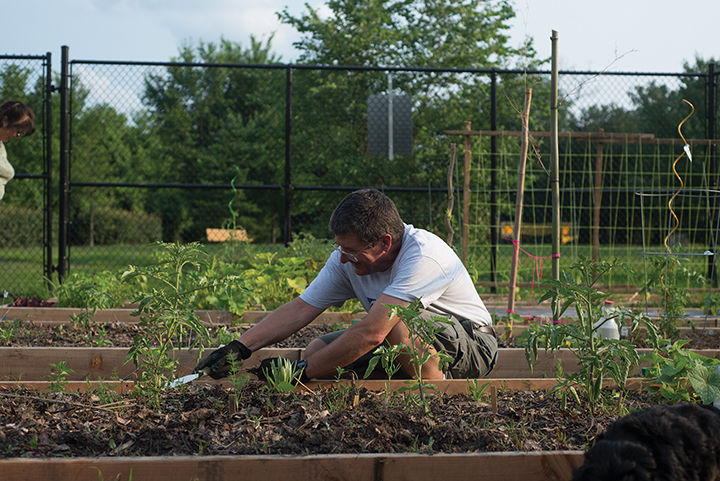
Doug Meade, a College Park resident, tends to his personal flower bed at the local community garden.
A few months after opening in May, the College Park community garden continues to grow as more residents sign up for plots of land in the once-abandoned volleyball court in the Old Town neighborhood.
After becoming a Sustainable Maryland Certified community in October 2013, the city signed a three-year plan with the community garden as one of the projects, said Steve Beavers, the city’s community development coordinator.
“We thought a few people would be interested and sign up,” Beavers said, noting that the list of gardeners keeps increasing as people become aware of the land. “If anything, the more people who stop by it will most likely sign up for a plot.”
The garden layout currently has 20 plots built — each plot costing $15 — and 16 residents are using 19 of them, Beavers said. He added the garden could expand to up to 40 plots, each of which is 5-by-10 feet, and could accommodate many more gardeners.
The city doesn’t plan to stop at just one community garden, District 3 Councilwoman Stephanie Stullich said.
“The idea is to have not just one community garden but multiple throughout the city that will be easily accessible,” Stullich said.
For now, the Old Town garden is open to any resident, and it especially benefits those who live in apartments or in a house with too much shade, she said. The land was once used as a volleyball court, but the location and amount of sunlight made it a good place for a garden, Beavers said.
Residents like John Bender from Calvert Hills have used this opportunity to grow their own vegetables.
“The neighborhood I live in has a lot of oak trees, so it’s not really possible to plant vegetables,” Bender said. “If you are willing to put in the work, it is a very satisfying way of getting fresh vegetables.”
Bender and his wife signed up for two plots in May and planted vegetables, including tomatoes, lettuce, peppers, cucumbers and yellow squash. Bender said he is grateful to the city, as he previously enjoyed planting in a community garden back in Chicago while he was in graduate school.
Another benefit of the garden is that it not only offers residents the chance to plant a fresh selection of fruits and vegetables, but also gives them a chance to meet more people in the city, Beavers said.
“In an area like Old Town with a wide variety of renters, you don’t find any place to bring them all together to socialize and meet,” he said. “This gives them a chance to come together. They meet people from the area and other parts of the city.”
Together, city residents have helped one another improve the soil through sessions called work nights, Beavers said. They swap tools and pitch in to make sure the plots are ready to be used.
So far there have been five work nights, with about eight to 15 people attending each, Bender said.
“It has a good impact on the environment,” Stullich said. “It’s also really good community-building that I hope will happen between students and residents.”
Overall, Stullich said the community garden is a positive step toward creating a more eco-friendly area for the city’s residents.
“I think many people care about the environment, and we want to live in a green, sustainable community, and a community that values that,” she said.



